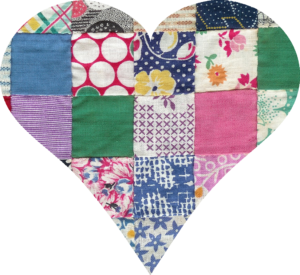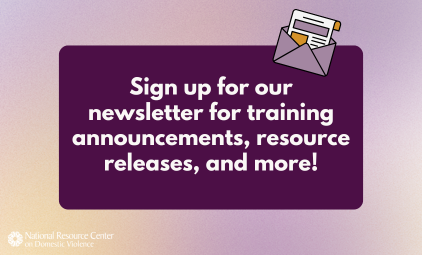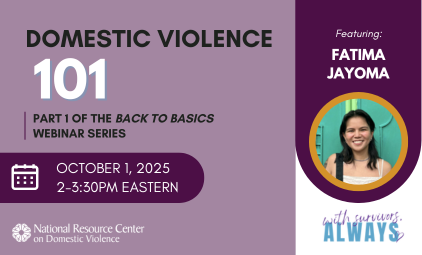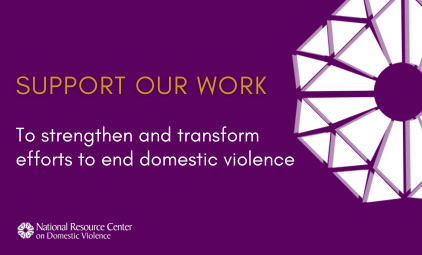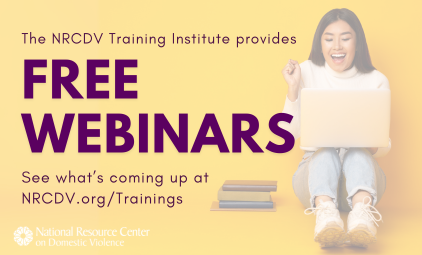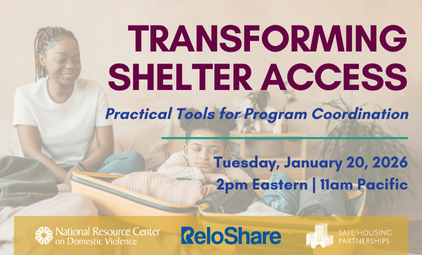by Patty Branco, Director of Training & Technical Assistance for the National Resource Center on Domestic Violence
On a daily basis, advocates are exposed to trauma through the stories of the survivors that we work with. In addition, many of us – as advocates, healers, organizers and activists – bring to this work our own experiences of violence and trauma, whether those experiences are historic or current, individual or collective. As we engage in the very important work of promoting social change and justice, we must commit to our individual and collective healing.
Our personal experiences “help determine what we think is possible, what impact we think we can have in the world, and how much we trust other people” (Generation FIVE, 2007). In this sense, our histories of violence and trauma can hinder our ability to build relationships, to envision a future without violence, and to access our strength to bring forth the transformation we seek to see in the world. Understanding historical trauma and supporting collective resilience are critical to effectively responding to instances of current violence. Most importantly, it is also a means to increasing our collective power as a social movement against systemic violence and oppression.
Understanding and confronting collective trauma
Collective or historical trauma is trauma that happens to large groups of people. It can result from colonialism, war, genocide, slavery, incarceration, terrorism, displacement, poverty, and natural or human-made disasters, among others. Research indicates, however, that responses to deliberate perpetration of mass trauma differ from those caused by accident or forces of nature, with trauma from deliberate intent creating a deeper sense of dismay and alienation (Sotero, 2006). According to Sotero (2006), “intentional violence threatens basic assumptions about an orderly, just world and the intrinsic invulnerability and worthiness of the individual.”
Moreover, collective trauma can be transmitted transgenerationally and across communities, and its impact may be felt by individuals, groups or entire cultures for years and even generations. The lasting impacts of slavery on African American communities, for instance, are discussed by Dr. Joy Degruy on her writings and videos on Post Traumatic Slave Disorder.
Video: What is Post Traumatic Slave Syndrome and the Effects
On an individual level, some of the symptoms of collective trauma include rage, depression, denial, survivor guilt, internalized oppression, and physiological changes in the brain and body that may result in chronic disease (Healing Collective Trauma, n.d.). In addition, research indicates that historical trauma is a precipitating factor influencing racial/ethnic health disparities. That is, populations historically subjected to long-term, mass trauma exhibit a higher prevalence of disease even several generations following the original trauma (Sotero, 2006).
On a broader level, as it relates to our social justice work, collective trauma can impact our ability to build health, wellness and collective power (Generation FIVE, 2007). As Garrigues (2013) states, “Unacknowledged historical trauma can keep social activists in a cerebral, disconnected state which has the potential to tear movements apart.” Therefore, confronting trauma and promoting healing and resilience are critical if we are to support the “individual and collective survival and resistance upon which the securing of social justice is built” (Generation FIVE, 2007).
Tapping into our culture and legacies of resilience
In Trauma to Resilience: Notes on Decolonization, Wesley-Esquimaux (2009) suggests that the most important factors that help First Nations women to bounce back from negative experiences in life are in their awakening cultural and social resiliency. Resilience is understood as this very ability to rebound from the traumatic experiences one encounters in life. It is an innate human capacity that can be learned and developed in anyone. And, as a process, “resilience allows for the integration of the teachings that those experiences present” (Wesley-Esquimaux, 2009).
“My story is very easily your story, an early narrative of trauma and grief that transformed into a story of healing and strength, a story about my arrival at the gate of ‘what is right for me’ and learning to walk well in both worlds, a story of delving deep into the traditions of Aboriginal people and being able to clothe myself in courage and a past that has given me a reason to celebrate. My story includes walking with increasing confidence, deeper into the world of the colonizer, and then finding my way out with gifts that shine light in both worlds. This story is also your story, a story about survival, about an innate resiliency born of an historic adversary and grief, about climbing large mountains, about finding your own way, about learning how to ‘victorize’ your journey, because, in the end, it is all about arriving home, wherever your heart belongs, strong and victorious.” – Cynthia C. Wesley-Esquimaux, Trauma to Resilience: Notes on Decolonization
It is important to honor and acknowledge that our unique cultures are vital forces in sustaining and passing on legacies of resilience. The What’s in the Heart video series (1, 2, 3) exposes the historical trauma inflicted upon American Indians and celebrates the triumph of culture and tradition in the face of such trauma. The videos highlight Native Americans leaders who are helping to heal their communities with remarkable programs and initiatives. One of the videos traces the life of a young Lakota boy who survived the Wounded Knee Massacre, and went on to forge a life based on forgiving “those who had done that to him.” Through his story and interviews with health experts and community leaders, the video shows how one community is using the best of traditional and modern medicine practices to heal from its past. One of the videos remind us of the prophesy of Black Elk who saw the present time as a time of restored hope and balance for Indian people.
Video: What’s in the Heart – Children of the 7th Generation
Honoring the role of culture as a repository of resilience and wisdom, the National Compadres Network promotes La Cultura Cura (Culture Heals), a “transformative health and healing philosophy that recognizes that within an individuals’, families’ and communities’ authentic cultural values, traditions and indigenous practices exist the path to healthy development, restoration and life long well being.” This indigenous-based framework focuses on the inherent potential and strengths within an individual, family, community or culture, and it uses physical, emotional, mental and spiritual principles and practices that are culturally grounded.
Generally, through various forms of collective resilience such as rituals, arts, spirituality, and storytelling, communities with shared histories of trauma and oppression have survived and even thrived throughout history. In this sense, “Collective resilience can be an antidote to collective grief” (Garrigues, 2013). Spirituality and connectedness, for example, are two of the many forms of collective resilience that have been employed by people of African descent in response to the historical trauma of slavery. In the words of three influential thinkers:
- “Slavery deepened our sense of spirituality. African people are highly, highly spiritual, and that spirituality kept us alive during slavery and still thrives today.” (Brenda Wade, Ph.D.)
- “It also increased our sense of interconnectedness. During slavery we learned to bond with other slaves who weren’t related to us. After your mother was sold, the woman who fed you and took care of you became your mother.” (Gail E. Wyatt, Ph.D.)
- “But most important, we have maintained our humanity in that we have not, as a group, become barbaric toward those who committed the worst atrocities against us.” (Joy DeGruy-Leary, Ph.D.)
Such strategies will likely continue to play a key role in supporting communities of color in healing from and resisting current systemic injustices, including institutional racism, social economic exclusion, hyper-incarceration and police brutality. Additional strategies – culturally and trauma-informed – have been compiled in “4 Self-Care Resources for Days When the World is Terrible” by Colorlines.
“Caring for myself is not self-indulgence. It is self-preservation, and that is an act of political warfare.” – Audre Lorde
Moreover, in recent years, the #BlackLivesMatter movement is helping us to reimagine the future (see their guiding principles). The goals of this movement are to build connections between Black people and allies to fight anti-Black racism, to spark dialogue among Black people, and to facilitate connections necessary to encourage social action and engagement. “Rooted in deep love, this network of organizers is helping the U.S. wake up, face our demons and address the way racism has shaped this country, while holding a fierce conviction that another world is possible. They are one chapter in a long arc of spiritual warriors and freedom fighters” (Movement Strategy Center, 2016).
“So here we are amazingly alive, against long odds…” – Bud Osborn
As a social justice movement to end gender-based violence, our collective power and strength are fundamentally intertwined and reliant on our ability to reinvent ourselves and heal from individual and collective trauma. As we heal from wounds inherited from previous generations, we are best equipped to address and resist current experiences of violence and oppression. And, only when we address the trauma and violence directly inflicted upon ourselves, are we able to help others and effectively tackle systemic violence and oppression. By promoting and supporting resilience and healing, we allow ourselves and others to stay connected, to hold on to hope and to refuel the flame within our social justice hearts.
Video: Playing For Change is a movement created to inspire and connect the world through music
Join the 7th National Call of Unity: Healing the Heart of the Movement
Join us on Tuesday, October 4, 2016 at 3:00pm eastern as we commemorate the beginning of the National Domestic Violence Awareness Month with the National Call of Unity! On this annual, free 45-minute call, we intend to lift up resiliency and wellness as a transformative response to the violence and trauma experienced by our communities. The Call of Unity will bring together national organizers, government officials, advocates, and survivors to talk about the ways we can achieve lasting healing and justice, through transformative social change. (See full schedule of NRCDV-sponsored activities for DVAM.)
What forms of collective resilience has your community used to survive and thrive in the face of trauma and oppression?










